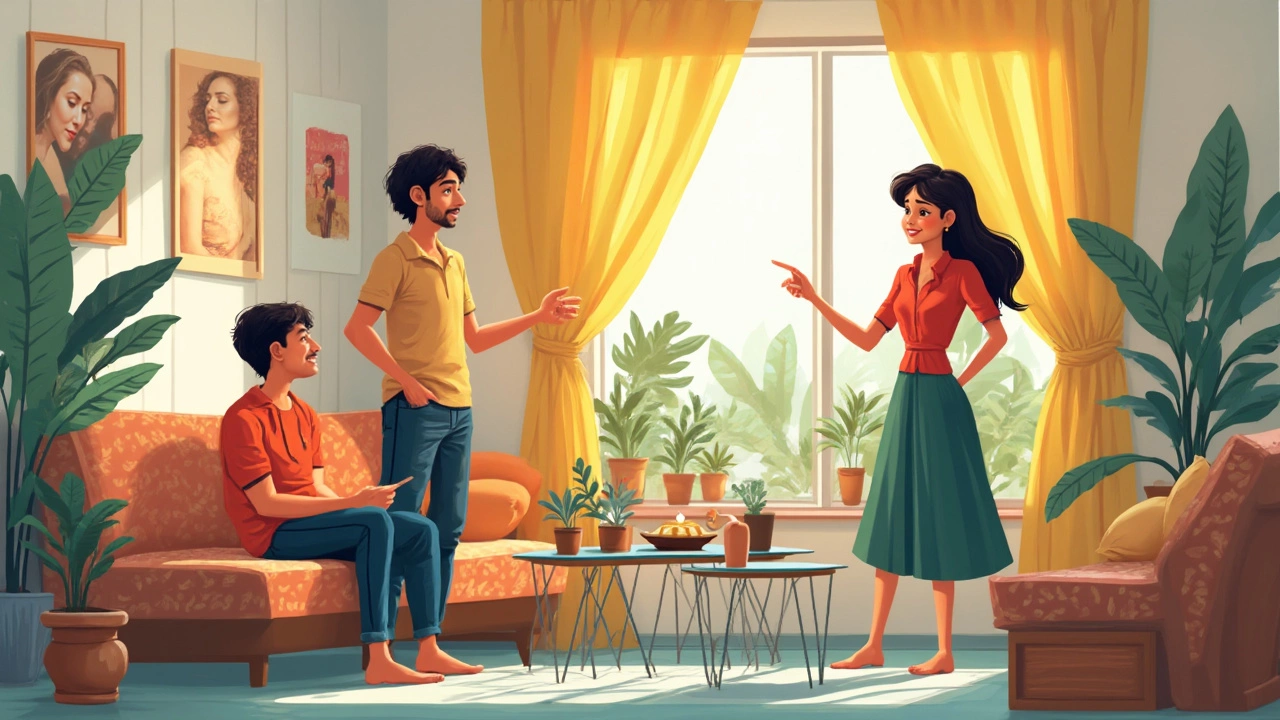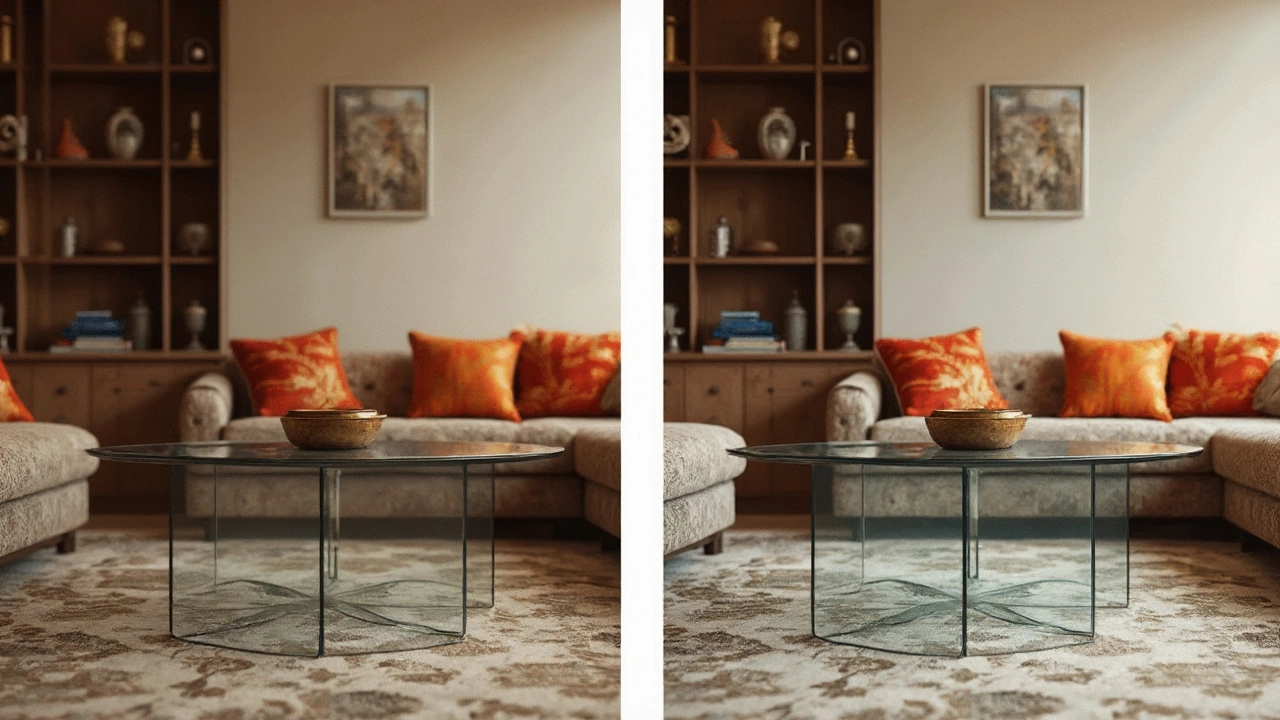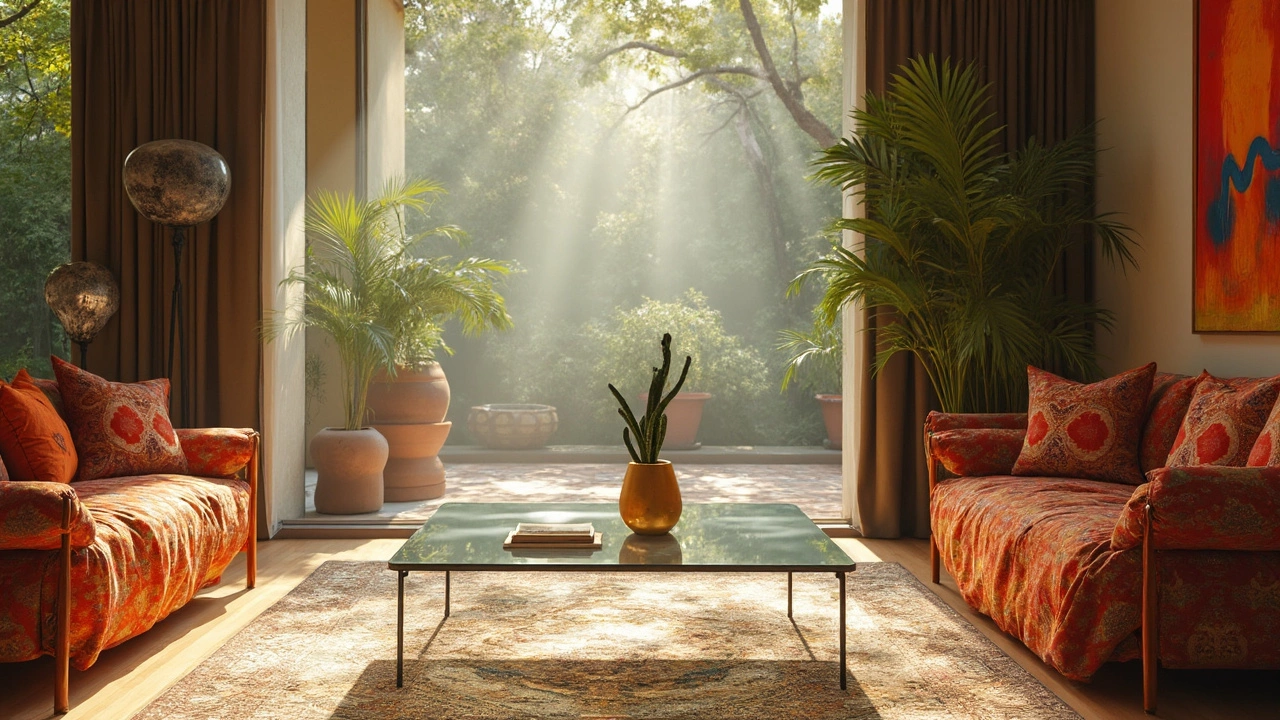Walk into a room with a glass coffee table, and something odd happens: the space just feels more open. Is this just some designer hype, or is there real science behind it? Honestly, glass tables aren’t magic, but they do play sneaky tricks with your eyes.
The big deal is how glass lets you see through to the floor, furniture, and walls behind it. This see-through effect means your eyes don’t hit a chunky solid block in the middle of the room—so the whole area reads as bigger and less crowded. Especially if your living room is on the smaller side, a glass coffee table doesn’t fight for attention. It gives your sofa and rug a chance to take center stage, which keeps the room from feeling stuffed.
But there are more things to think about before you shop. Placement, size, and even the style of glass table you choose all change how much open space you really feel. Ready to spot the hacks and avoid rookie mistakes? Let’s get into the details that actually make a difference.
- How Glass Tables Play Tricks with Space
- When a Glass Coffee Table Works Best
- What to Avoid: Glass Table Mistakes
- Smart Tips for Making Any Room Feel Larger
- Glass Table Maintenance and Longevity
How Glass Tables Play Tricks with Space
If you’ve ever wondered why designers rave about glass tables, it’s not because they’re showing off. It’s about how your eyes process what they see. With a glass coffee table, the clear top means you see straight through to the floor or rug underneath. This gives the illusion that the table isn’t even there, which stops the room from feeling crowded.
This trick works best if you’ve got a small or medium-sized living room. Instead of a big, bulky table blocking up the center, a glass one blends right in. Your area feels more open, less boxed-in. Even a heavy glass base won’t close off the view as much as a wooden or metal table would.
There’s a lot of science behind it, too. Our brains naturally read uninterrupted “lines of sight” as open and spacious. Removing visual blocks (like a chunky table) helps rooms seem bigger. In fact, studies in environmental psychology show that transparent furniture can make a space feel up to 20% larger compared to using entirely solid pieces.
- Glass tables let natural light move through, so even rooms with fewer windows feel brighter.
- Your favorite rug won’t disappear under the table—it stays visible and actually stands out more.
- The room’s flow improves, which just means moving around feels more comfortable and natural.
Want to know a secret? Stores use these same tricks all the time to make showrooms look huge. They’ll often use see-through coffee tables or display stands to keep things looking light and airy. If you want that clean, uncluttered vibe at home, glass is hard to beat.
When a Glass Coffee Table Works Best
If you're tight on space, a glass coffee table can be a real lifesaver. In apartments or smaller living rooms, these tables practically disappear, letting you see every inch of floor and helping the whole place feel less “crammed.” That’s especially true if you’ve got dark or bulky seating—a glass top softens the look and makes things way less boxy.
Bright, naturally lit rooms are perfect for glass tables. Sunlight bounces through the glass and keeps the whole vibe feeling light and airy. If you like to keep things minimal, a simple glass table blends in, while letting you show off stylish rugs or cool flooring. Interior designers often use them in open-concept rooms to avoid “chopping up” the space visually.
Here's where glass shines (literally and figuratively):
- Small spaces – No visual clutter, so nothing feels blocked off.
- Modern or minimalist style – Clean lines and see-through isn’t just cool, it’s practical.
- Rooms with beautiful rugs or flooring – Let those features be the star.
- Homes with lots of light – Glass amplifies brightness, so the room feels even bigger.
If you love to play with color or décor, a glass table is a blank slate. You can swap pillows, throws, and centerpieces without worrying about clashing styles. Plus, if you ever move or shuffle your furniture around (like half of us do every few months), the table slides right in with pretty much any look.
Got kids or pets? Some newer glass tables come with tempered glass. It’s about four times stronger than regular glass, which means it’s less likely to shatter. A quick note, though—if your gang loves rowdy indoor games, you might want a style with rounded edges.
Want a snapshot of when glass really delivers? Check out this quick table:
| Room Type | Glass Coffee Table Impact |
|---|---|
| Small Apartment | Makes the area feel bigger, less cluttered |
| Sunlit Living Room | Boosts natural light, adds airiness |
| Open Floor Plan | Keeps sightlines open, no interruption |
Pick the right moment, and a glass table really pulls its weight. It doesn’t just sit there—it makes everything else look even better.

What to Avoid: Glass Table Mistakes
Picking a glass table for your space can backfire if you skip a few key details. Not every glass coffee table is going to make your room look bigger—sometimes, the wrong choice does just the opposite.
First, size matters. People often go for tables that are too big because they think, "Bigger must mean better value," but a huge piece eats up real estate and messes with sight lines. Measure your room and make sure there's at least 18 inches between your table and the sofa or TV stand. That open gap is what keeps the area feeling roomy.
Next, check the base. Bulky bases—think thick wood or heavy black metal—really kill the open vibe a glass table can give. Solid, chunky legs draw attention and visually block off sections of the room. Go for slim, simple bases, or even ones that almost vanish from view. This keeps the "see-through" illusion going.
Here’s something folks often miss: glass thickness. Super thick glass sounds sturdy but makes the table look heavy. Thin is best if you’re after that light, floating effect, but don’t go so thin that you worry about breakage—aim for about 1/2 inch (12 mm) thick for coffee tables, which is the norm for most brands anyway.
For families with kids, watch the corners. Sharp edges on a clear table? If you have little ones running around, that’s a recipe for a bruise or worse. Go for rounded corners or tempered glass to stay safer without losing that open look.
- Don’t clutter the top with too many books, vases, or trays. A glass table works magic best when there’s less on it. Too much stuff drags the eye right back and cancels the whole clear, open feel.
- Avoid dirty or smudged glass. Yes, smudges are way more visible on glass than wood or stone. Keep some glass cleaner and microfiber cloth handy—and make a quick wipe part of your routine.
If you’re into numbers, check out this quick comparison of common glass coffee table faults:
| Error | How It Affects Room Look |
|---|---|
| Too large table | Makes room feel cramped, even with glass |
| Chunky base/legs | Blocks sight lines, kills airy look |
| Thick glass top | Adds visual weight, looks bulky |
| Sharp corners | Safety hazard and breaks the “soft” feel |
| Cluttered tabletop | Destroys open and minimal vibe |
The trick is to balance style and safety. If you pick the right glass table with a light feel, safe edges, and minimal clutter, you’ll nail the open-space look. Skip these steps and you’ll wonder why your room still feels tight—even if you can technically see through your coffee table.
Smart Tips for Making Any Room Feel Larger
If you’re trying to make your space feel as open as possible, there’s more to it than just picking a glass table. Lots of tricks out there actually work, and most of them are easy (and budget-friendly) to pull off.
First off, declutter like you mean it. Small stuff laying everywhere makes a space shrink, fast. Baskets under coffee tables or wall shelves can corral the chaos without looking heavy. And on the subject of shelves, putting them closer to the ceiling draws the eye up, making ceilings look taller.
Light is your friend. Use mirrors across from windows to bounce natural light all over; even a small mirror can double the brightness in a sad corner. Try picking lighter shades for paint and furniture—think beige or soft gray. Dark colors tend to suck up light, making things feel tight.
Coffee tables in glass are just part of the puzzle. Go for “leggy” furniture—tables and chairs that look lifted off the ground—so there’s more visible floor space, which means more visual openness. A good rule with rugs: make sure they’re big enough to fit most of your furniture. Rugs that are too small break up the room, which works against that big-room feeling.
Want proof? According to the American Home Furnishings Alliance, 61% of interior decorators say that a clear surface—like a glass table—ranks as one of the top three ways to make a room seem more open. But it’s not just about buying stuff. Rearranging what you already own is just as powerful.
“Think of glass tables as visual gaps. They let your eye travel further, and that tiny trick of perception honestly works, especially in small apartments.” — Jordan Ellis, interior design consultant, quoted in Real Simple magazine.
To put things into steps, here’s what you want to try:
- Keep the floor as clear as possible—pick furniture with slimmer legs and stash extra stuff elsewhere.
- Use mirrors and glass surfaces to reflect light and space.
- Stick with light, neutral colors for large pieces and walls.
- Choose bigger rugs that anchor the whole sitting area, not just a tiny patch.
- Declutter surfaces and go minimal with decorations on your coffee table.
Stacking these strategies can make your living room feel double its size, even if the square footage says otherwise.

Glass Table Maintenance and Longevity
So, you like the open look that a glass table gives. But what about the work to keep it looking sharp? Here’s the straight truth: glass coffee tables aren’t tricky to care for, but they do demand some real-world attention if you want them to stay stunning for the long haul.
The number one thing with glass is fingerprints. Smudges, dust, and water rings show up fast. A quick wipe-down with glass cleaner (or even just a damp microfiber cloth) keeps your table looking fresh. Experts usually say to avoid paper towels since they can leave streaks or lint behind. If there’s anything sticky, use a mild dish soap with warm water, but skip rough sponges—those can scratch.
Speaking of scratches, no glass is totally immune. Tempered glass, which is what most glass coffee tables use these days, is much harder than regular glass. It resists chips and breaks way better, but it’s still a good idea to use coasters and avoid tossing keys or heavy objects onto the surface. If you have kids or pets running around, edge guards can be a lifesaver against sharp corners.
- Wipe with microfiber cloth regularly
- Use coasters for drinks (especially coffee or soda)
- Clean sticky messes with diluted dish soap, not harsh chemicals
- Add rubber or silicone bumpers under the table legs to avoid sliding
- Lift objects instead of sliding them to prevent scratches
Don’t forget, glass tables can support a lot of weight if they’re made right. But overtime, stress on the frame can create tiny cracks—so don’t load up the table with stacks of books or heavy decor. While it might be tempting to use your glass coffee table as a makeshift bench or step stool (don’t laugh, we’ve all thought about it), that’s a recipe for a shattered disaster.
For a little perspective, most tempered glass tables have a lifespan of 5-15 years depending on use. And good news—high-quality glass won’t turn cloudy or yellow with age, so you won’t suddenly be stuck with a table that looks tired by year three.
| Glass Table Care Step | Frequency |
|---|---|
| Wipe with glass cleaner | 2-3 times a week |
| Inspect for chips or cracks | Monthly |
| Tighten hardware/frame | Every 6 months |
Bottom line: if you want that airy, make-the-room-look-bigger vibe, the maintenance isn’t a headache. Just treat your glass table with a little care, and it’ll keep your space looking clean and modern for years.

